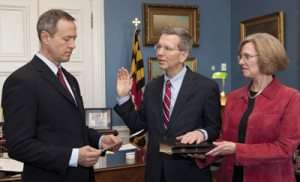Dear USAA:
You have some of the best, most sophisticated adjusters of any car insurance company out there. Generally speaking, you make more reasonable settlement offers than the other companies with big car insurance market share in Maryland (better than GEICO, State Farm or Allstate). Sure, you force us to try some cases against you to pay our clients a fair settlement value. And, yes, you would probably shoot your own parents in the head to save a buck. But, really, in the insurance company world of relativity, you are not that bad.
Now that I have finished the flattery, could you do me one small favor? Teach your insurance adjusters in personal injury cases that there is something called the collateral source rule in Maryland. You simply cannot deny a lost wage claim because you “suspect the client was being paid anyway.”
At first, I thought it was just one bodily injury adjuster at USAA who did not understand Maryland law. But I’m now convinced that less than half of USAA adjusters understand this rule.
Even more maddening, when the adjuster is called out on this obvious point of law that Maryland has had for – count them – 112 years, that the claimant is paid for time missed from work regardless of whether they used vacation time or their employer paid them out of the goodness of their heart, USAA adjusters simply refuse to admit or deny the existence of the collateral source rule.
Thank you in advance for your anticipated cooperation.
Sincerely,
Ron Miller
New Maryland Circuit Court Judges
In all the hubbub about Robert McDonald’s selection to the Maryland Court of Appeals, I neglected to mention the new Circuit Court judges:
- Baltimore County District Judge Nancy Purpura (Baltimore County)
- William Rogers Nicklas Jr., a personal injury lawyer (Frederick County)
Bob McDonald Pick for Maryland Court of Appeals
The Maryland Daily Record is reporting that Governor O’Malley today named Robert N. “Bob” McDonald to the Maryland Court of Appeals. Soon to be Judge McDonald is the chief counsel of the Opinions, Advice and Legislation Division in the Office of the Maryland Attorney General where he has been for 15 years.
McDonald writes or edits all formal opinions of the Attorney General’s Office. I don’t have occasion to read many Attorney General opinions and, even if I did, I don’t think it would be a great lens to predict how McDonald will vote. Ultimately, the AG is making the call on those opinions.
There are a lot of 4-3 decisions by the Court of Appeals. I have no idea how this will affect that court and I doubt many people do.
Top 10 Maryland Personal Injury Opinions of 2011
This is a time of year for top 10 lists. So I have put together a list of the top 10 opinions of interest to personal injury lawyer from the Maryland Court of Appeals and the Maryland Court of Special Appeals and from the federal bench:
- Poole v. Coakley Williams Construction: the court softens its position on snow and ice slip and falls.

- Jackson v. Dackman Company: court strikes 1994 Reduction of Lead Paint in Housing Act provisions that limit recoveries to children who suffer brain damage from lead paint
Bragging About Your Verdict
The Defense Line – a publication of the Maryland Defense Institute – publishes a quarterly newsletter that includes a few “Hey, look, Ma, we got a defense verdict” pieces. Here is a sample:
Johnson, et al. v. Dr. Rosemarie Filart, M.D., et al. — Bonner Kiernan Obtains Defense Verdict in the Circuit Court for Baltimore City, Maryland — Alleged Medical Malpractice/Wrongful Death
A 53 year old man, [name deleted], developed deep vein thrombosis (DVT) after completing a course of anticoagulant therapy prescribed by Dr. Rosemarie Filart of Johns Hopkins. One of his primary care physicians, Dr. Mark Saba, subsequently placed the patient on a blood thinner to treat the DVT, but Mr. Johnson still went on to suffer from a pulmonary embolism (PE) and died. The decedent’s family (including a wife and two adult
children) filed a lawsuit against Dr. Filart, Dr. Saba, and Dr. Saba’s partner, Dr. Lawrence Boas, alleging that Mr. Johnson’s pulmonary embolism was a result of the premature discontinuation of anticoagulant therapy (by Dr. Filart) and/or improper treatment of the DVT (by Saba and/or Boas). Drs. Boas and Saba, represented by E. Phillip Franke and Ace McBride of Baxter Baker Sidle Conn & Jones, were both voluntarily dismissed by the plaintiffs in the middle of the trial. Plaintiffs elected to continue their case against only Dr. Filart, represented by Carolyn Israel Stein and Jason Engel of Bonner Kiernan Trebach & Crociata. After a three week trial, the jury returned a defense verdict in favor of Dr. Filart after 45 minutes of deliberation. Plaintiffs had sought $1,200,000 in economic damages, plus noneconomic damages for the decedent’s alleged pain and suffering and the family member’s suffering due to the loss of their decedent.
Slip and Fall Verdict Reversed: Sovereign Immunity Strikes Again
The Maryland Court of Special Appeals turned back another injured victim under the archaic “Really, do we still have that in 2011?” doctrine of sovereign immunity.
The plaintiff alleged she suffered an ankle injury when she slipped and fell on a wet platform after exiting a train at the Cheverly Metro station in Prince George County. The defendant, the beloved Washington Metropolitan Area Transit Authority, made all the usual – and appropriate – defenses. You knew the platform was wet, didn’t you? You even saw a yellow warning cone that the platform was wet, right? No one appeared to have mopped the floor to make it wet, did they?
The plaintiff’s lawyers got creative and did some research. They found out that WMATA used a cleaning agent “Super Shine-All” to clean its train platforms. The coefficient of friction on the floor, the plaintiff argued, was that it should have surprised no one that the woman would fall. In a trial before Judge Maureen M. Lamasney, a Prince George’s County jury agreed and awarded damages (I’m not sure how much). Continue reading
Drunk Driving by Maryland County
I was always into statistics. When I was little, baseball statistics were the outlet. I was doing Moneyball when Billy Beane was still learning what a double steal is. (This is hyperbole. I like to exaggerate the things I saw coming.)
Like a lot of us, I looked at risk differently when I became a parent. Now I’m more interested in what the authors of Freakonomics tell us about what matters when raising a child. (Here’s the transcript of a podcast I recently listened to which I found more than a little depressing. It really makes you question the efficacy of piano lessons.)
Freakonomics interests me because it uses statistics to assess the risk that questions largely held assumptions. I try to use statistics in parenting to make sure my kids are avoiding the risks that we can reasonably avoid. Car accidents are on a big blip on the radar screen. Car accidents are a major risk of serious injury and death for young children, a far greater risk that 95% of the things you worry about as a parent.
Road Rage Judge Steps Down
The Washington Post reports that Montgomery County Judge Brian G. Kim resigned after reports of a road rage incident circulated.
Apparently, Judge Kim was accused of tailgating a woman – yes, it matters to me – because he was believing he’d been cut off. She reported to the police that Judge Kim was “zooming up beside me, yelling through the windows and gesturing.” She also said that the Honda reached about 70 mph and zoomed over to her lane, causing her to slam on her brakes to avoid a wreck.
I don’t know if it made a difference, but judges that make a lot of enemies on the bench have a much harder time making it through a minor scandal. Court Watch Montgomery was not really excited about Judge Kim after sitting in on six months of restraining-order hearings in Montgomery County.
State Farm v. Chiropractors | The War on Litigation Related Treatment
Update: this case was still going on in 2018 which is insane. I don’t like State Farm as much as the next plaintiffs’ lawyer. But I understand State Farm’s larger point on this issue, which I explain below.
In State Farm v. Cavoto, a Pennsylvania appellate court decided a battle between two parties who are always at odds, State Farm and chiropractors. Usually, the skirmishes between these parties are fought by proxy but, in this case, they faced off directly.
Who Can Provide Treatment?
Essentially, State Farm got fed up with paying chiropractors who were billing for adjunctive procedures performed by support staff who were not licensed. Particularly, and arguably understandably, annoying to State Farm was unlicensed people applying hot and cold packs, turning on and off mechanical devices, using a traction machine, and assisting in therapeutic exercises. I’m sure that most infuriating to State Farm is paying for someone without medical training to apply hot and cold packs. If you can’t see why the insurer takes exception to that -regardless of how you view the merits of it – you may have had one drink too many from the plaintiffs’ attorney Kool-Aid.
The appellate court didn’t look at the case quite that way. Instead, the court applied the law that appears to allow unlicensed staff members to provide some treatment. The court reasoned that the real medical care was the decision to give the hot or cold packs and for how long, not who applied them. Similarly, the court reasoned, most elements of applying electrical muscle stimulation, ultrasound, and the like do not require specialized skills, as long as there is a chiropractor deciding the details and how the therapy should be applied. The court remanded the case back to the trial court to “make more specialized findings and determine whether any of the procedures allegedly performed by unlicensed personnel required formal chiropractic education or training, including a further inquiry by the court as to the scope of those procedures.”
Continue reading
$1 Million Verdict in “Brain in a Jar” Lawsuit
Awful story. Young and handsome 17-year-old boy is killed in a car accident. Inexplicably, the city morgue displays the child’s brain. Sure enough, the boy’s classmates go on a field trip to the morgue and see the boy’s brain floating in formaldehyde. How did they know it was his? The boy’s name was on it. (The story gets even worse.)
Seriously? The story sounds made up, right down to the part about the kids going on a field trip to the morgue. But no one disputes the facts. Incredible. I usually try to avoid “what a bunch of morons” type rhetoric on this blog. I’ll set that aside for this one. What a bunch of morons. The jury in this case agreed, awarding the family a million-dollar verdict.
Everyone at that morgue should be fired. No doubt. Still, we have to value the loss not of the boy but of the morgue’s negligence. The actual loss here is the boy’s death in the car accident, not what happened to some part of his body after the accident. The plaintiffs’ lawyer told the jury that the boy’s sister dropped out of school at age 14 because of devastating survivor’s guilt and relentless teasing by other students. Beyond tragic. But this is not what was at issue in this trial.



